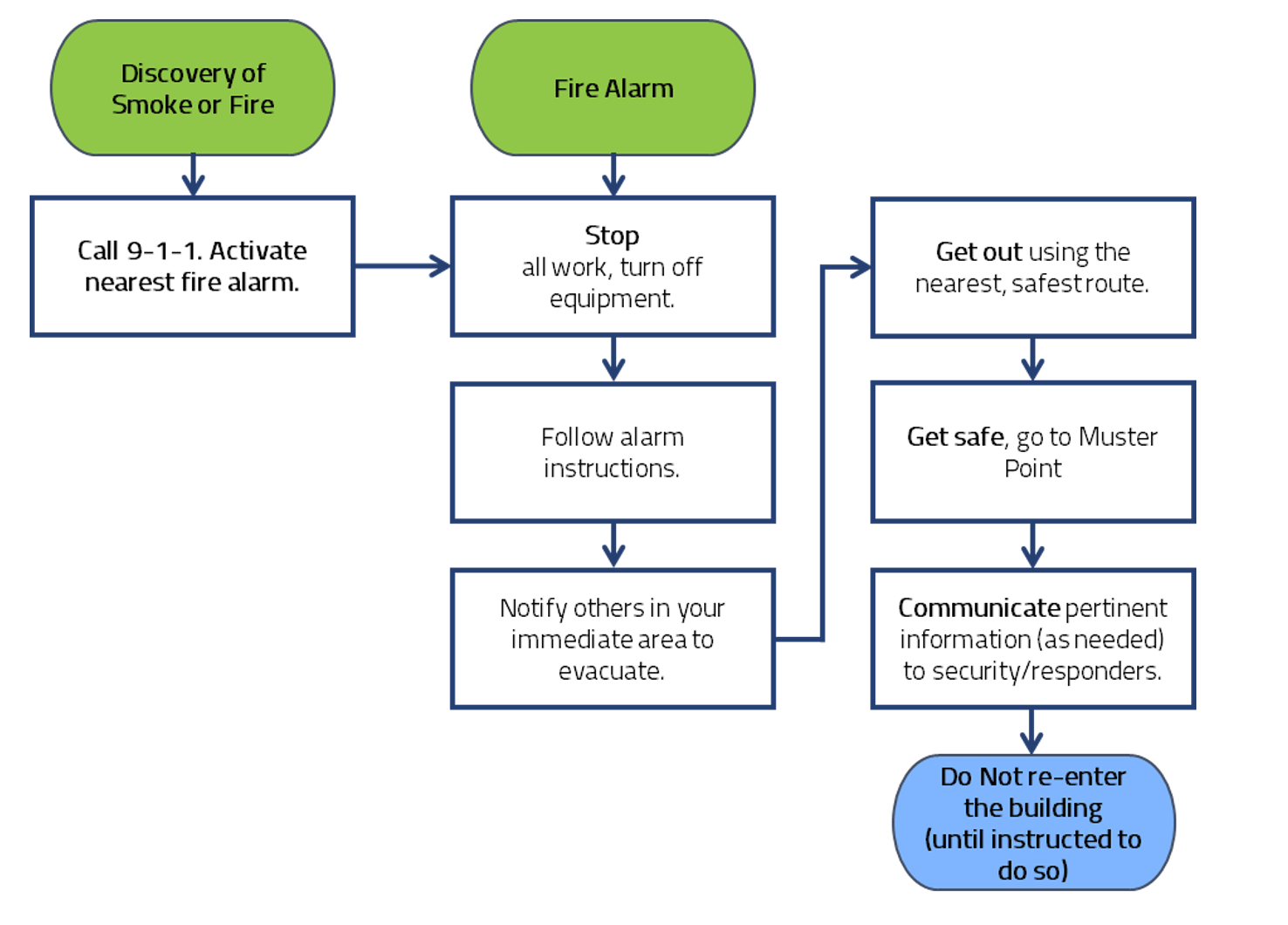In an emergency, staff, students, and visitors to campus may need to respond quickly and safely to reduce the risk of injury or damage. Familiarize yourself with the procedures below for emergency situations on campus. View our quick reference guide for more information.
Learn what to do in the following situations:
Get help in an emergency
In the event of an immediate life or death emergency, call 911.
For all on-campus emergencies, call Campus Security at 403.284.8000.
Evacuations and fire
If you see fire or smell smoke, activate the fire alarm and follow the SAIT occupant evacuation procedure.
Follow the directions of security, fire wardens and first responders.
Stop
If you need evacuation assistance, ask two buddies to stay with you and wait in the elevator lobby (if safe) and notify a Fire Warden or Security (403.284.8000). If you see any sign of smoke or fire, wait in a fire-rated stairwell (a concrete stairwell with a fire door) and call 911. The individual requiring assistance should take initiative to request for two evacuation buddies to stay with them (the evacuation buddies may be pre-arranged or arranged by the individual when an alarm occurs).
Get out
In the event of an evacuation, use the stairs. Do not use the elevators.
Get safe
SAIT’s Fire Warden program has volunteer Fire Wardens (not guaranteed due to hybrid work schedules) in permanent office spaces who assist with occupant evacuation.
Communicate
Fire Wardens will sweep designated office areas and relay essential information to Campus Security/first responders. Instructors are expected to sweep their classroom or lab space and communicate any pertinent information to Campus Security/first responders.
Fire life safety equipment
Fire life safety equipment around SAIT's campus is for the safety of everybody, and intentional tampering with equipment can result in mischief or criminal charges.
Report any of the following to Campus Security at 403.284.8000:
- The use of fire life safety equipment.
- Damage or the blockage of fire life safety equipment.
- Incorrect or accidental pull of an alarm.
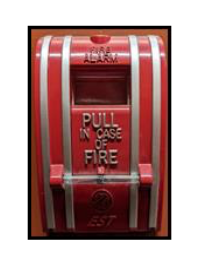 Fire alarm pull stations are typically red boxes that say "FIRE," and are located in all buildings, on all floors, and are generally found near exits.
Fire alarm pull stations are typically red boxes that say "FIRE," and are located in all buildings, on all floors, and are generally found near exits.
In case of smoke or fire, pull down as indicated to activate the building's fire alarm system.
If you incorrectly or accidentally pull an alarm, please immediately report it to Campus Security.
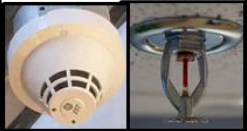 Smoke detectors and sprinkler heads are standard in every building and may be found directly or indirectly installed into the ceiling or off pipes and extensions.
Smoke detectors and sprinkler heads are standard in every building and may be found directly or indirectly installed into the ceiling or off pipes and extensions.
Take caution when extending or using equipment that could potentially impact the sprinklers.
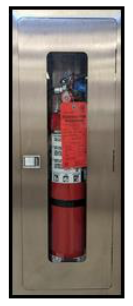 Fire extinguishers inside in-wall cabinets are located throughout every building and are typically near labs, washrooms and other open areas.
Fire extinguishers inside in-wall cabinets are located throughout every building and are typically near labs, washrooms and other open areas.
Use the fire extinguisher only if appropriate, safe and if you are trained or comfortable with operating the extinguisher.
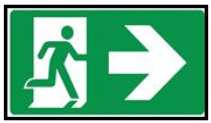 All exits and fire life safety equipment are to be free of obstruction and be visible at all times.
All exits and fire life safety equipment are to be free of obstruction and be visible at all times.
Fire alarms
All SAIT buildings have fire alarm systems to notify occupants of potential dangers that may lead to building evacuations.
Understanding the differences in alarm stages is important to know what to do when you hear an alarm.
Buildings:
- Temporary Wellness Centre
- E.H. Crandell building
- Eugene Coste building
- All satellite campuses, including:
- Art Smith Aero Centre
- Point Trotter Campus
- The Tastemarket
For buildings with single-stage alarms, evacuate immediately and follow the SAIT occupant evacuation procedure.
The single-stage alarm consists of rapid bells — generally three rings followed by a pause. There may be a pre-recorded message informing occupants to evacuate.
Buildings:
- Heritage Hall
- Clayton Carroll Automotive Centre
- Aldred Centre
- John Ware building
- East Hall Residence
- Cenovus Energy Centre
- Johnson-Cobbe Energy Centre
- Begin Tower Residence
- Stan Grad Centre
- Senator Burns Building
- Thomas Riley Building
For buildings with two-stage alarms, the first stage will be a notification of an incident in the building, and all occupants should remain in place. You should start shutting down equipment and packing up belongings.
The first-stage alert alarm usually sounds like one ring, followed by a three-second pause. There may be a pre-recorded message informing occupants of the alert stage.
Should the alarm change to the second stage, follow the SAIT occupant evacuation procedure.
The second-stage evacuation alarm consists of rapid bells — three rings followed by a pause. There may be a pre-recorded message informing occupants to evacuate.
If a fire alarm is pulled or smoke or fire is detected, the alarm will go to the second stage evacuation alarm immediately.
See the campus map for muster points.
Hazardous material
If hazardous materials are released, alert others in the immediate area and follow these steps below.
Isolate
Secure the area, close windows and doors and turn off sources of heat or anything that could cause a spark.
Decontaminate
If needed, remove clothing/accessories that may have been contaminated with a substance.
Assist
Only trained individuals should rescue or attend to injured students and individuals if the appropriate personal protective equipment is available.
Evacuate
If needed, follow building evacuation procedures.
Report
Call security at 403.284.8000 and follow the instructions. You'll also need to complete an incident report.
Scan
Assess the area for hazards.
Call 911
Listen to the instructions and provide the necessary information.
Call security
Contact security at 403.284.8000.
Do not move the ill or injured person unless it is essential for their safety. Provide first aid if you are trained, have appropriate personal protective equipment, and are comfortable doing so.
Submit an incident report post-treatment.
AED's
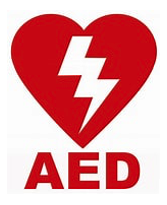 Automated external defibrillators (AEDs) are installed throughout SAIT. They may be used to help someone experiencing sudden cardiac arrest in an emergency. All the AEDs are registered with Alberta Health Services and 911 dispatch as knowledge of their location in the event of an emergency.
Automated external defibrillators (AEDs) are installed throughout SAIT. They may be used to help someone experiencing sudden cardiac arrest in an emergency. All the AEDs are registered with Alberta Health Services and 911 dispatch as knowledge of their location in the event of an emergency.
Look for the heart symbol on the campus map or see our list of AED locations .
If you use an AED or any components within the AED, submit an incident report so the unit can be inspected and replaced as needed.
Get out
Exit the building if you can and keep your hands visible to First Responders.
Hide
If you can't run, hide. Turn off the lights, silence your phone, stay quiet, stay hidden.
Fight
As a last resort, if you cannot escape, fight the assailant with an object and use as much force as necessary to reduce the threat.
The Campus Alberta Risk and Assurance Committee (CARA), — made up of SAIT and several other Alberta post-secondary institutions — launched an initiative to educate staff and students about how to respond in the case of an assailant.
This video is a dramatization of an active shooting scenario. A voiceover and on-screen instructions support the dramatization.
Police experts were consulted during the development of this video.
Watch: Surviving an active shooter incident*
*The content of this video may be disturbing to some viewers.
Shelter-in-place
You may be directed to shelter-in-place if there is an external environmental or hazardous material threat.
If instructed to shelter in place:
Go indoors
Close all windows and doors
Stay away from exterior walls and windows
Close off and block air circulation/ventilation equipment or systems if required
Remain indoors and await further direction from security or first responders
Download SAITALERT
SAITALERT is a free smartphone app for the SAIT community to help keep you safe on and around campus.
Contact us
Campus Security
Q100, Eugene Coste building, SAIT Main Campus
-
Phone - Emergency: 403.284.8000
-
Phone - 403.284.8530
-
Email - campus.security@sait.ca
-
24 hours / 7 days a week

Oki, Âba wathtech, Danit'ada, Tawnshi, Hello.
SAIT is located on the traditional territories of the Niitsitapi (Blackfoot) and the people of Treaty 7 which includes the Siksika, the Piikani, the Kainai, the Tsuut’ina and the Îyârhe Nakoda of Bearspaw, Chiniki and Goodstoney.
We are situated in an area the Blackfoot tribes traditionally called Moh’kinsstis, where the Bow River meets the Elbow River. We now call it the city of Calgary, which is also home to the Métis Nation of Alberta.

